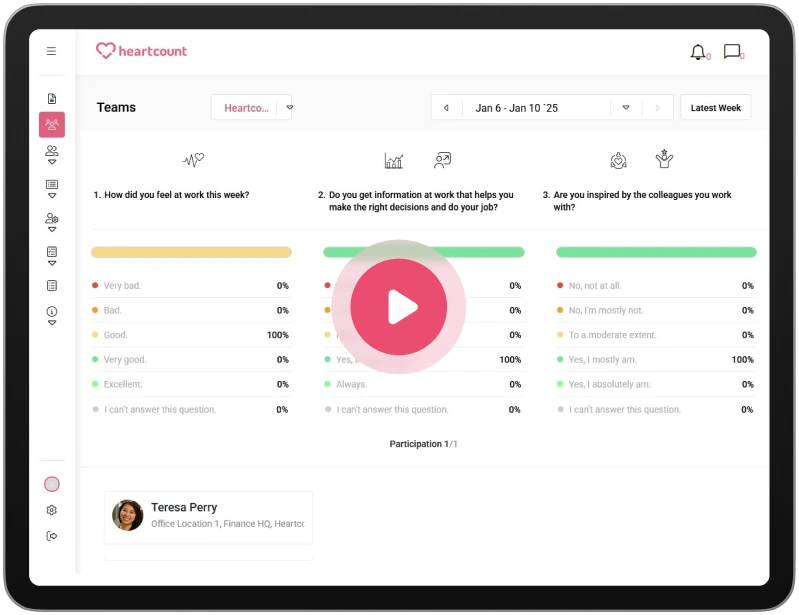10 examples of innovation in the workplace you should apply

Innovation is often misunderstood as a grand, expensive venture reserved for tech startups or research labs. This couldn’t be further from the truth.
Innovation in the workplace doesn’t involve just inventions; it’s about finding better ways to do things, big or small. It’s not exclusive to a specific department or role, nor does it require a hefty budget or cutting-edge technology.
It’s a continuous process that thrives on diverse perspectives and a culture of experimentation.
Employee innovation is crucial because it drives growth, competitiveness, and adaptability. It fuels problem-solving, enhances employee engagement, and ensures organizational survival in a rapidly changing market.
Innovation is often misunderstood as a grand, expensive venture reserved for tech startups or research labs. This couldn’t be further from the truth.
Innovation in the workplace doesn’t involve just inventions; it’s about finding better ways to do things, big or small. It’s not exclusive to a specific department or role, nor does it require a hefty budget or cutting-edge technology.
It’s a continuous process that thrives on diverse perspectives and a culture of experimentation.
Employee innovation is crucial because it drives growth, competitiveness, and adaptability. It fuels problem-solving, enhances employee engagement, and ensures organizational survival in a rapidly changing market.
What actually is innovation in the workplace?
Innovation in the workplace refers to introducing new ideas, methods, products, or services to improve organizational performance and achieve competitive advantage.
It involves using employees’ creativity and expertise to create value and solve challenges within the company.
Types of innovation in the workplace include:
- Product innovation refers to developing new or improving existing products to meet customer needs and market demands.
- Process innovation means enhancing the efficiency and effectiveness of internal operations, such as streamlining workflows or automating tasks. It often leads to reduced costs and better quality.
- Business model innovation involves rethinking how the company creates, delivers, and captures value. It can involve exploring new revenue streams, customer segments, or value propositions.
- Marketing innovation refers to finding new ways to reach and engage customers through digital marketing or personalized campaigns.
- Organizational innovation involves implementing new structures, cultures, or leadership approaches to creativity and collaboration. It can include changes in leadership, decision-making, or employee empowerment.
- Social innovation implies solving problems that create shared value for the organization and society. It can include solutions for social causes like poverty, education, or healthcare.
Benefits of an innovative workplace
Innovation fuels organizational success and employee fulfillment. Nurturing a culture of creativity and experimentation can reap numerous benefits for both.
Benefits of employee innovation for the organizations
Companies can achieve numerous advantages by creating a culture of creativity and experimentation:
- Improved employee engagement: Employees involved in innovative projects feel more connected to the company’s goals and are more likely to be passionate about their work. They’ve higher job satisfaction, motivation, and a stronger sense of ownership over their roles, which leads to higher productivity.
- Stronger competitive advantage: By introducing new or improved products or services, a company can establish a distinct market position and acquire clients who seek something different or better than competitors. A strong competitive advantage leads to higher market share, pricing power, and customer loyalty.
- Increased revenue and profitability: New products and services can open new revenue streams. Additionally, process improvements can lead to cost reductions, increased efficiency, and higher profit margins.
- Enhanced brand reputation: A company known for innovation is often a leader in its industry. A strong brand reputation attracts customers who value these attributes, making the company more appealing to investors and potential employees.
- Improved efficiency and productivity: Companies can improve their efficiency and productivity by streamlining operations, eliminating waste, and automating tasks. These innovations lead to faster production times, lower costs, and higher output.
- Greater adaptability to change: Innovative companies can quickly adapt their product offerings, business models, or processes to meet new challenges and opportunities. Agility is crucial for long-term success in a highly competitive market.
Benefits for employees
Innovation fuels personal and professional growth. Employees in innovative cultures enjoy the following advantages:
- Increased job satisfaction: Working on innovative projects offers employees a sense of accomplishment and pride. It can also provide a welcome break from routine tasks, leading to higher morale and overall job satisfaction.
- Opportunities for growth and development: Innovation often requires learning new skills and taking on new challenges, which lead to career advancement, increased knowledge, and a broader skill set.
- Enhanced sense of purpose: Employees who contribute to innovative solutions feel they’re making a meaningful impact on the company and its customers. This can lead to a stronger sense of purpose and fulfillment in their work.
- Improved work-life balance: Innovative workplaces often prioritize efficiency and employee well-being. By streamlining processes and adopting new technologies, they reduce workload and create a healthier work-life balance for employees.
- Financial rewards: Many companies offer incentives for innovation, such as bonuses, profit-sharing, or equity. Employees can get tangible rewards for their contributions, which motivates them to continue generating new ideas.
COLLECT
The link between employee innovation and engagement
Innovation and engagement form a dynamic, self-perpetuating cycle. Each one catalyzes the other, creating continuous momentum and driving growth.
Let us explain:
When employees feel valued, enthusiastic about their work, and connected to the company’s goals, they’re more likely to be engaged. Engaged employees are happier and more invested, so they’re more willing to share ideas, work with colleagues, and look for ways to improve the company. As W. Edwards Deming, an American economist and business theorist, states: “Innovation comes from people who take joy in their work.”
In turn, innovative companies often make their employees feel more valued and excited to be part of the team, which raises engagement and productivity.
The numbers support these claims. 94% of respondents to APIAR’s “Innovation through employee engagement” study confirm a positive relationship between engagement and innovation, and 63% view innovation as a form of engagement.
Encouraging employees to contribute ideas and solutions brings:
- Improved engagement and investment in their work. Employees who feel their ideas are valued become more invested in their roles. Seeing their contributions implemented creates a sense of purpose and connection to the company’s goals. Increased engagement leads to greater job satisfaction and a stronger desire to contribute.
- Increased sense of ownership and accountability. Employees involved in problem-solving feel more ownership over the outcomes. They’re committed to the company’s success, as they’re more likely to take responsibility for their actions and work results.
- Enhanced motivation and enthusiasm. Recognizing and implementing employee ideas improves morale and creates a positive work environment. Employees feel empowered, and their motivation and enthusiasm rise. Seeing their contributions directly impact the company fuels a desire to generate innovative solutions.
- Improved collaboration and teamwork. Encouraging idea-sharing promotes a culture of collaboration. Employees are likelier to collaborate to develop and refine ideas, feeling camaraderie and shared purpose.
- Enhanced problem-solving skills. Problem-solving develops stronger analytical and critical thinking skills. Employees learn to identify issues, analyze potential solutions, and evaluate the impact of different approaches. Improved problem-solving ability benefits individual and team performance.
- Increased creativity and innovation. Encouraging out-of-the-box thinking and experimentation leads to innovation. Employees who feel safe proposing unconventional solutions develop new products, services, or processes.
10 examples of innovation in the workplace
Innovation is about finding better ways to work. The following examples of innovation in the workplace showcase how different approaches can drive success.
1. Self-managed teams
Traditional hierarchical models often stifle creativity and hinder problem-solving. In contrast, self-managed teams empower employees to take ownership of their work, make decisions, and manage their tasks without constant supervision.
This approach nurtures autonomy and responsibility, increasing job satisfaction and engagement. By granting employees more control over their work, self-managed teams encourage innovation, as employees feel more secure taking risks and exploring new ideas.
2. Continuous feedback loops
Continuous feedback loops involve the regular exchange of information between employees and managers to boost growth, development, and alignment with organizational goals.
Creating an open dialogue allows you to proactively identify emerging trends, address challenges, and capitalize on opportunities. This iterative process cultivates a culture of learning, adaptability, and employee engagement, all essential for driving innovation.
To streamline the feedback process and gain actionable insights, consider implementing a dedicated platform like HeartCount.
This software provides HR teams and management with real-time data on employee sentiment, enabling them to spot and correct possible issues early.
HeartCount’s three-question surveys, covering key aspects of job satisfaction, offer a quick yet comprehensive pulse check.

Additionally, features like Pulse Checks, Personal Feedback, and Custom Surveys allow for tailored feedback collection, while Kudos and Private Messages facilitate positive reinforcement and open communication.
Moreover, the anonymity and confidentiality options allow employees to freely share their thoughts, encouraging trust and openness.
By leveraging HeartCount’s data-driven approach and employee-centric features, organizations can create a feedback culture that empowers employees, drives innovation, and ultimately enhances overall performance.

3. Employee recognition platform
Employee recognition platforms systematically acknowledge and reward employee contributions. By providing a structured channel for praising achievements, milestones, and exemplary work, these platforms contribute to a positive and appreciative work culture.
They’re crucial for innovation as they encourage employees to feel valued and invested in their roles. When recognized, employees are more likely to take risks, share ideas, and contribute. Furthermore, you can use an employee recognition platform to highlight innovative projects, increase their visibility, and inspire others.
Besides feedback, HeartCount encourages peer-to-peer recognition. Simple yet effective, this function strengthens team spirit and enforces an open feedback culture. Your employees can praise and acknowledge the good things they see their co-workers do with little or no hierarchical oversight.
By celebrating successes and creating a psychologically safe space for experimentation, these platforms significantly contribute to innovation culture.

4. Cross-functional collaboration
Cross-functional collaboration means bringing together people from different departments with diverse skill sets to achieve a shared goal. This approach breaks down silos, encouraging the exchange of ideas and perspectives.
Cross-functional teams can identify innovative solutions to complex problems by combining expertise from various areas. Linda Hill, Harvard Business School professor, confirms that “Innovation is the result of the collaboration of people with diverse expertise and diverse perspectives coming together, being able to collaborate, experiment together, and learn.”Additionally, 70% of employees believe improved collaboration can positively impact productivity and save time.
5. Transparent and anonymous work planning
Transparent work planning involves sharing project plans, goals, and timelines with all relevant stakeholders. Information about what work needs to be done, who is responsible for it, and when it needs to be completed is openly accessible to everyone. The goal is a shared understanding of the project, improved employee participation, and enhanced accountability.
Anonymous work planning removes individual names from project plans. Instead of assigning tasks to specific people, tasks are listed without identifying the person responsible. This approach can help reduce bias, prevent favoritism, and encourage a focus on the work rather than the individuals doing it. It can also help to share the workload more evenly and reduce the fear of failure or judgment.
6. Employee wellness programs
Employee wellness programs promote a healthier, happier, and more engaged workforce.
Employees who prioritize their well-being experience increased energy, focus, and creativity. Reduced stress levels and improved health contribute to a sharper mind and a greater ability to think critically and generate new ideas.
Focusing on employee well-being reduces absenteeism and presenteeism, increasing productivity and efficiency and allowing for greater focus on strategic initiatives and experimentation.
7. Flexible work schedules
Granting employees more autonomy over their work hours and location increases innovation.
Flexibility improves work-life balance, reduces stress, and increases job satisfaction. A happier workforce will likely be engaged, creative, and productive.
Flexible work attracts and retains top performers, allowing individuals to balance personal and professional lives. A highly skilled workforce brings fresh perspectives and ideas, fostering innovation.
Beyond individual benefits, flexible work schedules lead to operational efficiencies. Organizations can improve performance by optimizing work hours to align with peak productivity periods. Additionally, flexible arrangements can reduce turnover and absenteeism, leading to cost savings and increased stability.
8. Sustainable practices
Sustainable practices aren’t just a corporate responsibility but a cornerstone of innovation. By including environmental and social factors in their operations, companies have to rethink and create new solutions.
The drive for sustainability encourages creativity, leading to advancements like renewable energy technologies. It also cultivates a culture of innovation, where employees seek to improve efficiency and reduce waste, benefiting both – the planet and the company’s progress.
9. Purpose-driven culture
Employees who feel connected to a company’s higher purpose are likelier to be engaged, passionate, and committed to their work. High engagement fuels creativity, problem-solving, and a willingness to take risks, all essential components of innovation.
Moreover, a purpose-driven culture attracts and retains top talent seeking meaningful work. These individuals bring diverse perspectives and fresh ideas, creating a dynamic and innovative work environment.
10. Flexible workspaces
By offering employees a variety of work environments, including open collaboration areas, quiet focus rooms, and remote work options, companies cater to diverse work styles and preferences. Flexibility enhances employee satisfaction, productivity, and creativity.
Flexible workspaces promote innovation by encouraging cross-functional collaboration. Employees interacting with colleagues from different departments in a casual setting gain new ideas and perspectives.
Additionally, these spaces often incorporate technology that facilitates knowledge sharing and remote collaboration, further fueling innovation.
10 best practices to encourage innovation and creativity in the workplace
A successful innovation program requires a strategic approach. These best practices provide a roadmap for creating an innovative workplace that sparks creativity and drives groundbreaking ideas.
1. Nurture open communication
Open communication is an environment where ideas can freely flow, be challenged, and refined. When employees share their ideas and perspectives without fear of judgment or reprisal, their creativity can flourish.
Workplace transparency also facilitates knowledge sharing, enabling employees to build upon each other’s ideas and develop innovative solutions to complex problems.
Moreover, it helps to identify potential obstacles or challenges early on, allowing teams to address them proactively.
2. Encourage collaboration and knowledge-sharing
Join employees with diverse perspectives and expertise to stimulate idea generation and problem-solving. Employees sharing knowledge and insights create a collective intelligence that can lead to breakthroughs and innovative solutions.
Collaboration can help to break down silos, improve communication, and strengthen connections among team members.
3. Embrace diversity
Diversity, in all its forms – including but not limited to gender, age, ethnicity, culture, and thought – is a powerful catalyst for innovation. Different perspectives, experiences, and backgrounds bring unique problem-solving approaches and ideas.
When teams include individuals with diverse viewpoints, they’re better equipped to challenge assumptions, identify new opportunities, and develop creative solutions.
Moreover, diversity creates a more inclusive and respectful culture, which increases employee engagement and satisfaction.
4. Create a culture of innovation
A stimulative culture encourages experimentation, risk-taking, and creative thinking.
Employees who feel empowered to share ideas and see their efforts valued are more likely to be engaged and motivated to innovate.
A culture of innovation also helps attract and keep top talent, as people are drawn to organizations that prioritize creativity and progress.
5. Encourage innovation at all levels
Despite most executives recognizing the importance of innovation, a McKinsey survey shows a big gap between their goals and actual outcomes: 80-90% prioritize innovation, but only 6% are satisfied with the results.
Innovation isn’t solely the domain of senior leadership or dedicated innovation teams. “Isolating or segmenting “innovation” into its own corner sends the message that other individuals or teams either cannot or don’t get to be part of the “innovation party” – says Jim Loter, Deputy Chief Technology Officer at the City of Seattle.
If you encourage innovation at all levels of an organization, you’ll create a powerful ripple effect, leading to a more agile and responsive business.
By empowering employees at every level to contribute ideas and solutions, you can discover a lot of hidden creativity. This bottom-up approach also contributes to a better sense of ownership and involvement among employees, who feel valued and committed to the company’s success.
6. Challenge assumptions
Assumptions often inhibit innovation, limit creativity, and prevent exploring new possibilities. By actively challenging these preconceived notions, you can stimulate out-of-the-box thinking and generate groundbreaking ideas.
Innovation flourishes when employees are encouraged to question the status quo and explore alternative approaches. This practice also helps identify inefficiencies and improvement areas, driving operational excellence and a competitive advantage.
7. Take the fear out of innovation and embrace failure
Contrary to popular belief, failure is not the enemy of innovation but an essential component of it. Erik Kikuchi, EOS implementer, confirms this, adding that “If you’re not making mistakes, the challenge isn’t great enough.”
You’ll support experimentation and risk-taking by creating a culture where failure is seen as a chance to learn rather than a setback.
Employees who aren’t afraid to fail are likelier to push boundaries, try new approaches, and achieve outstanding results. Moreover, learning from failures helps build resilience and flexibility, which are vital for success in today’s business world.
8. Focus on employee development
Employees who can develop, grow, and learn new skills become more confident, engaged, and equipped to tackle challenges with fresh perspectives.
Continuous learning cultivates a growth mindset, encouraging employees to explore new ideas and solutions. Additionally, skilled and knowledgeable employees are more likely to contribute innovative ideas and take on new responsibilities.
9. Provide resources and support
Providing adequate resources and support contributes to innovation and creativity. These involve:
- Financial resources for research, development, and experimentation
- Access to technology – software, hardware, and digital tools
- Dedicated workspace, equipment, and supplies
- Time to explore new ideas and concepts
- Guidance and support from experienced colleagues
- Opportunities to develop skills related to innovation and creativity
- Autonomy to experiment and make decisions
- A stimulative work environment where employees can take risks
Employees with the tools, knowledge, and freedom to experiment are more likely to generate creative ideas. By investing in resources and offering support, you can create an atmosphere where employees take risks and explore new possibilities.
10. Reward and recognize innovation
By acknowledging and appreciating employees’ innovative contributions, you can motivate them to go the extra mile, push boundaries, and generate new ideas. Public recognition can inspire others to contribute their creative solutions, creating a positive innovation cycle.
UNDERSTAND
Make room for innovation
Innovation is a cornerstone of organizational success. It’s not about grand, expensive projects but about finding better ways of working. It’s fueled by employee creativity and thrives in environments that encourage experimentation and collaboration.
To create an innovative workplace, prioritize open communication, employee development, and a culture of experimentation. And remember: innovation is a journey, not a destination. By empowering employees and providing a stimulating environment, you can unlock your company’s full potential.
Are you ready to embrace innovation? Discover how HeartCount can alter your workplace. As a platform created to improve communication, connect employees and management, and promote a healthy company culture, HeartCount is your partner in creating an innovative and dynamic workplace.









